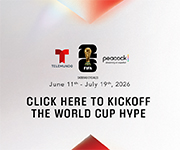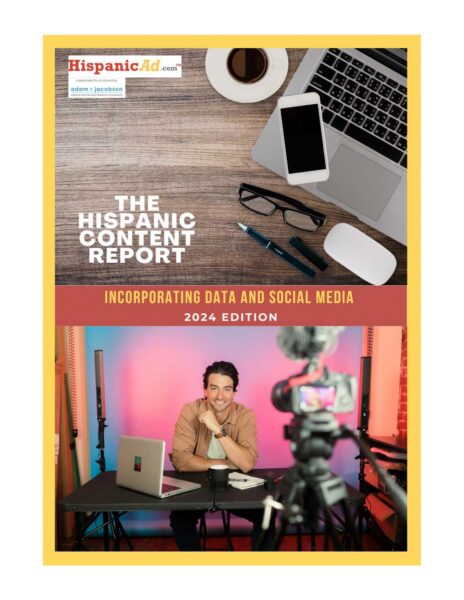John Gallegos’ Beer
 Founded at the crossroads of cultures, SouthNorte Beer Co. revealed that it has secured new investment to drive company growth led by advertising executive and founding partner, John Gallegos, who has increased his investment in the brand to further accelerate the company’s marketing efforts, expansion into new territories and exploration of new partners throughout the country. This influx of funding positions Gallegos as the majority owner of SouthNorte, with Coronado Brewing Company offering continued operational support with a minority stake in the company.
Founded at the crossroads of cultures, SouthNorte Beer Co. revealed that it has secured new investment to drive company growth led by advertising executive and founding partner, John Gallegos, who has increased his investment in the brand to further accelerate the company’s marketing efforts, expansion into new territories and exploration of new partners throughout the country. This influx of funding positions Gallegos as the majority owner of SouthNorte, with Coronado Brewing Company offering continued operational support with a minority stake in the company.


 Technology will continue to redefine the media landscape in 2020, creating opportunities and challenges for marketers. As ad spend on social and tech platforms continues to grow; technology innovations will also enable a renaissance in real-world engagement. According to Kantar’s global 2020 Media Trends & Predictions report marketers and media owners will be challenged to develop the skills, engagement models and measurement capabilities to meaningfully engage consumers in the crowded media landscape.
Technology will continue to redefine the media landscape in 2020, creating opportunities and challenges for marketers. As ad spend on social and tech platforms continues to grow; technology innovations will also enable a renaissance in real-world engagement. According to Kantar’s global 2020 Media Trends & Predictions report marketers and media owners will be challenged to develop the skills, engagement models and measurement capabilities to meaningfully engage consumers in the crowded media landscape. Hispanic ad dollars are only 6% of the total U.S. ad spend, yet Hispanics comprise over 19% of the total population. This represents a significant discrepancy and a missed opportunity for brands and marketers. by Karla Fernandez Parker
Hispanic ad dollars are only 6% of the total U.S. ad spend, yet Hispanics comprise over 19% of the total population. This represents a significant discrepancy and a missed opportunity for brands and marketers. by Karla Fernandez Parker  We have the key to the city–or 50 cities, to be exact. For the 2020 Surge Cities index, Inc. and innovation policy company Startup Genome analyzed troves of data on seven essential indicators–such as early-stage funding and job creation–to determine the 50 best areas for startup growth. In the following dispatches, you’ll find a road map for turning forgotten ZIP codes into boomtowns–or simply for answering the age-old question: Where should you go next? From Charleston to Chattanooga, the answers may surprise you.
We have the key to the city–or 50 cities, to be exact. For the 2020 Surge Cities index, Inc. and innovation policy company Startup Genome analyzed troves of data on seven essential indicators–such as early-stage funding and job creation–to determine the 50 best areas for startup growth. In the following dispatches, you’ll find a road map for turning forgotten ZIP codes into boomtowns–or simply for answering the age-old question: Where should you go next? From Charleston to Chattanooga, the answers may surprise you. Hemisphere Media Group Reaches Multi-Year Distribution Agreement with DISH Network to restore Puerto Rico’s highest-rated broadcast network WAPA Televisión, WAPA Deportes, and WAPA América, to its service.
Hemisphere Media Group Reaches Multi-Year Distribution Agreement with DISH Network to restore Puerto Rico’s highest-rated broadcast network WAPA Televisión, WAPA Deportes, and WAPA América, to its service. As America marches steadily toward a majority-minority population, culture and authenticity will play larger roles in how products and services are developed and marketed. Authenticity influences culture, but data suggests that it is not a key driver of brand choice. by Mario Carrasco – Think Now
As America marches steadily toward a majority-minority population, culture and authenticity will play larger roles in how products and services are developed and marketed. Authenticity influences culture, but data suggests that it is not a key driver of brand choice. by Mario Carrasco – Think Now Thanks to a strong labor market, US consumers are feeling good about the economy. Unemployment is at a historical low, wages are rising at their fastest rate since the onset of the recession, and consumption continues to grow at a steady clip.
Thanks to a strong labor market, US consumers are feeling good about the economy. Unemployment is at a historical low, wages are rising at their fastest rate since the onset of the recession, and consumption continues to grow at a steady clip. The Suncoast Chapter of the National Academy of Television Arts and Sciences awarded Telemundo 51 Miami / WSCV, NBC6 Miami / WTVJ, Telemundo Puerto Rico / WKAQ-TV, Telemundo 49 Tampa / WRMD and Telemundo 31 Orlando / WTMO a combined total of 31 Suncoast Regional Emmy® Awards during the 43nd Annual awards gala held on Saturday, December 14 at the Hyatt Regency in Orlando, Florida.
The Suncoast Chapter of the National Academy of Television Arts and Sciences awarded Telemundo 51 Miami / WSCV, NBC6 Miami / WTVJ, Telemundo Puerto Rico / WKAQ-TV, Telemundo 49 Tampa / WRMD and Telemundo 31 Orlando / WTMO a combined total of 31 Suncoast Regional Emmy® Awards during the 43nd Annual awards gala held on Saturday, December 14 at the Hyatt Regency in Orlando, Florida. LaLiga North America introduce a brand-new documentary series, Latinos in LaLiga, that features intimate and in-depth interviews with the Latino stars of the world’s best futbol league.
LaLiga North America introduce a brand-new documentary series, Latinos in LaLiga, that features intimate and in-depth interviews with the Latino stars of the world’s best futbol league. Spanish Broadcasting System, Inc. (the “Company” or “SBS”) (OTCQB: SBSAA) announced that in connection with its planned recapitalization, SBS has received a letter from a recognized multinational financial services broadcast lender stating that it is highly confident of its ability to arrange secured debt financing for SBS in an amount of $300 million. The debt financing will carve out certain non-core real estate and broadcast station assets so that, in connection with the recapitalization, SBS will be positioned to obtain a separate and incremental first lien asset-based financing facility.
Spanish Broadcasting System, Inc. (the “Company” or “SBS”) (OTCQB: SBSAA) announced that in connection with its planned recapitalization, SBS has received a letter from a recognized multinational financial services broadcast lender stating that it is highly confident of its ability to arrange secured debt financing for SBS in an amount of $300 million. The debt financing will carve out certain non-core real estate and broadcast station assets so that, in connection with the recapitalization, SBS will be positioned to obtain a separate and incremental first lien asset-based financing facility. For marketers eager to reach generation Alpha, the story is instructive. Born — and yet-to-be born — between 2010 and 2025, Alphas are conditioned to an always-on society and the ongoing screenification of culture. Dubbed Alphas by Australian social scientist Mark McCrindle, this is the first generation entirely born in the 21st century — “alpha” is the first letter of the Greek alphabet — and Alphas probably knew their way around an iPad before they learned how to walk. Mostly the progeny of tech-savvy millennials, they live in a digital second skin and take for granted a connected world in which they have 24-7 access to a constant flow of information. Equally important — even though they’re barely old enough to cross the street unaccompanied — they have an adult-sized influence on their household’s purchasing behavior.
For marketers eager to reach generation Alpha, the story is instructive. Born — and yet-to-be born — between 2010 and 2025, Alphas are conditioned to an always-on society and the ongoing screenification of culture. Dubbed Alphas by Australian social scientist Mark McCrindle, this is the first generation entirely born in the 21st century — “alpha” is the first letter of the Greek alphabet — and Alphas probably knew their way around an iPad before they learned how to walk. Mostly the progeny of tech-savvy millennials, they live in a digital second skin and take for granted a connected world in which they have 24-7 access to a constant flow of information. Equally important — even though they’re barely old enough to cross the street unaccompanied — they have an adult-sized influence on their household’s purchasing behavior. For a long time, demographic information (such as age, gender and location) was the only way companies could segment their customer base. Today that is no longer the case. The wealth of consumer data now available means brands can layer attitudinal and behavioral insights on top of demographic data to paint a far richer, more nuanced picture of real people.
For a long time, demographic information (such as age, gender and location) was the only way companies could segment their customer base. Today that is no longer the case. The wealth of consumer data now available means brands can layer attitudinal and behavioral insights on top of demographic data to paint a far richer, more nuanced picture of real people. The winner of the 2020 Presidential Election will need to reach 270 electoral votes. Getting to that number will mean understanding who’s voting and who’s not, and who can be engaged, so they’ll turn out at the polls. Whether you want to engage in a “get out the vote” campaign, or focus messaging efforts in key swing states, you’ll want to tune in each month as we explore voters and their role on the road to election 2020.
The winner of the 2020 Presidential Election will need to reach 270 electoral votes. Getting to that number will mean understanding who’s voting and who’s not, and who can be engaged, so they’ll turn out at the polls. Whether you want to engage in a “get out the vote” campaign, or focus messaging efforts in key swing states, you’ll want to tune in each month as we explore voters and their role on the road to election 2020. By Gonzalo López Martí Creative director, etc. / lmmiami.com
By Gonzalo López Martí Creative director, etc. / lmmiami.com
 2020 ends the ‘General market era’ glorified by Madison Ave. where my career started, and Minority-Majority is officially an oxymoron. The states driving our economy are already majority-Multicultural, Gen Z will be in 2020, Millennials by 2025, Gen X before 2030, the U.S. by 2040. Over half of all USA HHs today are Multicultural or mixed races, over half of Hispanics under age 29, over half of Blacks grew up as digital natives, and Asians are the most affluent and educated of any racial group with $110K average HH income. The Census will only reinforce the urgency of revisioning these high value super-consumers who will account for $4.2T buying power next year and all future growth, while Non-Hispanic-Whites decline at an accelerated rate as deaths exceed births, putting brands that don’t do proper Multicultural marketing at risk. By Liz Castells-Heard, CEO & Chief Strategy Officer, INFUSION
2020 ends the ‘General market era’ glorified by Madison Ave. where my career started, and Minority-Majority is officially an oxymoron. The states driving our economy are already majority-Multicultural, Gen Z will be in 2020, Millennials by 2025, Gen X before 2030, the U.S. by 2040. Over half of all USA HHs today are Multicultural or mixed races, over half of Hispanics under age 29, over half of Blacks grew up as digital natives, and Asians are the most affluent and educated of any racial group with $110K average HH income. The Census will only reinforce the urgency of revisioning these high value super-consumers who will account for $4.2T buying power next year and all future growth, while Non-Hispanic-Whites decline at an accelerated rate as deaths exceed births, putting brands that don’t do proper Multicultural marketing at risk. By Liz Castells-Heard, CEO & Chief Strategy Officer, INFUSION Hiring an advertising agency is an art. No matter how scientific one is during a search process, there is always a significant degree of subjectivity associated with it. This is especially true when hiring a segment agency, where one may not be a subject matter expert. By Isaac Mizrahi – Co-President of ALMA
Hiring an advertising agency is an art. No matter how scientific one is during a search process, there is always a significant degree of subjectivity associated with it. This is especially true when hiring a segment agency, where one may not be a subject matter expert. By Isaac Mizrahi – Co-President of ALMA This year was chockful of defining moments. From ongoing trade disputes with China and political unrest, to legalized marijuana and online privacy concerns. In our final report of the year, 2019 Defining Moments: Insights Into Culture and Authenticity™, we highlight trends in consumer sentiment, purchase behavior, and digital media use, and explore the impact culture has on these trends. We’ve combined these insights into a brief narrative of Total Market consumer behavior over the last twelve months and marketing predictions for 2020.
This year was chockful of defining moments. From ongoing trade disputes with China and political unrest, to legalized marijuana and online privacy concerns. In our final report of the year, 2019 Defining Moments: Insights Into Culture and Authenticity™, we highlight trends in consumer sentiment, purchase behavior, and digital media use, and explore the impact culture has on these trends. We’ve combined these insights into a brief narrative of Total Market consumer behavior over the last twelve months and marketing predictions for 2020.


























